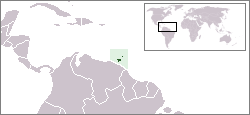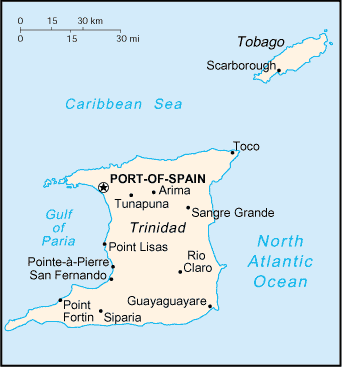|
Heights Of Aripo Village
Heights of Aripo Village is located in the Northern Range of the island of Trinidad. It is presumed this village, which lies in known Amerindian territory of the Nepuyo people, was at one point inhabited by first peoples. The work provided by later Cocoa Estates would have been a major draw for labour and settlers in the twentieth century. Few of the Estate houses remain many Cocoa Houses are still visible in the community either repurposed and inhabited or dilapidated. Most of the villagers have moved away from cocoa production, agricultural production still remains a big part of the community. The area is now the second largest producer of watercress on the island and the village has been working with The Caribbean Natural Resources Institute (CANARI) to further business opportunities for the village and help its sustainability. See also *El Cerro del Aripo *Geography of Trinidad and Tobago Trinidad and Tobago is an archipelagic republic in the southern Caribbean between ... [...More Info...] [...Related Items...] OR: [Wikipedia] [Google] [Baidu] |
Arima
Arima, officially The Royal Chartered Borough of Arima is the easternmost and second largest in area of the three boroughs of Trinidad and Tobago. It is geographically adjacent to Sangre Grande and Arouca at the south central foothills of the Northern Range. To the south is the Caroni–Arena Dam. Coterminous with Town of Arima since 1888, the borough of Arima is the fourth-largest municipality in population in the country (after Port of Spain, Chaguanas and San Fernando). The census estimated it had 33,606 residents in 2011. In 1887, the town petitioned Queen Victoria for municipal status as part of her Golden Jubilee celebration. This was granted in the following year, and Arima became a Royal Borough on 1 August 1888. Historically the third-largest town of Trinidad and Tobago, Arima is fourth since Chaguanas became the largest town in the country. Geography Climate The borough has a tropical rainforest climate ( Köppen ''Af''), bordering on a tropical monsoon ... [...More Info...] [...Related Items...] OR: [Wikipedia] [Google] [Baidu] |
Trinidad
Trinidad is the larger and more populous of the two major islands of Trinidad and Tobago. The island lies off the northeastern coast of Venezuela and sits on the continental shelf of South America. It is often referred to as the southernmost island in the West Indies. With an area of , it is also the fifth largest in the West Indies. Name The original name for the island in the Arawaks' language was which meant "Land of the Hummingbird". Christopher Columbus renamed it ('The Island of the Trinity'), fulfilling a vow he had made before setting out on his third voyage. This has since been shortened to ''Trinidad''. History Caribs and Arawaks lived in Trinidad long before Christopher Columbus encountered the islands on his third voyage on 31 July 1498. The island remained Spanish until 1797, but it was largely settled by French colonists from the French Caribbean, especially Martinique.Besson, Gerard (2000-08-27). "Land of Beginnings – A historical digest", ''Newsday Ne ... [...More Info...] [...Related Items...] OR: [Wikipedia] [Google] [Baidu] |
Trinidad And Tobago
Trinidad and Tobago (, ), officially the Republic of Trinidad and Tobago, is the southernmost island country in the Caribbean. Consisting of the main islands Trinidad and Tobago, and numerous much List of islands of Trinidad and Tobago, smaller islands, it is situated south of Grenada and off the coast of northeastern Venezuela. It shares maritime boundary, maritime boundaries with Barbados to the northeast, Grenada to the northwest and Venezuela to the south and west. Trinidad and Tobago is generally considered to be part of the West Indies. The island country's capital is Port of Spain, while its largest and most populous city is San Fernando, Trinidad and Tobago, San Fernando. The island of Trinidad was inhabited for centuries by Indigenous peoples of the Americas, Indigenous peoples before becoming a colony in the Spanish Empire, following the arrival of Christopher Columbus, in 1498. Spanish governor José María Chacón surrendered the island to a British fleet under t ... [...More Info...] [...Related Items...] OR: [Wikipedia] [Google] [Baidu] |
Northern Range
The Northern Range is the range of tall hills across north Trinidad, the major island in the Republic of Trinidad and Tobago. The hills range from the Chaguaramas peninsula on the west coast to Toco in the east. The Northern Range covers approximately twenty-five percent of the land area of Trinidad. Geography The Northern Range runs from the Chaguaramas Peninsula in the west to Toco in the east. The eastern Northern Range (areas east of Arima) remain most heavily forested. Portions west of Arima, especially the southern slopes and valleys, have been extensively deforested, since they lie immediately north of the most heavily populated parts of the island. At the western end of the Northern Range, the capital city, Port of Spain, climbs into the hills and the valleys are settled and largely deforested. The Arima Valley remains as the westernmost valley that is still primarily forested, in a large part due to the presence of the Asa Wright Nature Centre in this valley. T ... [...More Info...] [...Related Items...] OR: [Wikipedia] [Google] [Baidu] |
Amerindian
The Indigenous peoples of the Americas are the inhabitants of the Americas before the arrival of the European settlers in the 15th century, and the ethnic groups who now identify themselves with those peoples. Many Indigenous peoples of the Americas were traditionally hunter-gatherers and many, especially in the Amazon basin, still are, but many groups practiced aquaculture and agriculture. While some societies depended heavily on agriculture, others practiced a mix of farming, hunting, and gathering. In some regions, the Indigenous peoples created monumental architecture, large-scale organized cities, city-states, chiefdoms, states, kingdoms, republics, confederacies, and empires. Some had varying degrees of knowledge of engineering, architecture, mathematics, astronomy, writing, physics, medicine, planting and irrigation, geology, mining, metallurgy, sculpture, and gold smithing. Many parts of the Americas are still populated by Indigenous peoples; some countries have ... [...More Info...] [...Related Items...] OR: [Wikipedia] [Google] [Baidu] |
Indigenous Peoples
Indigenous peoples are culturally distinct ethnic groups whose members are directly descended from the earliest known inhabitants of a particular geographic region and, to some extent, maintain the language and culture of those original peoples. The term ''Indigenous'' was first, in its modern context, used by Europeans, who used it to differentiate the Indigenous peoples of the Americas from the Europeans, European settlers of the Americas and from the African diaspora, Sub-Saharan Africans who were brought to the Americas as Slavery, enslaved people. The term may have first been used in this context by Thomas Browne, Sir Thomas Browne in 1646, who stated "and although in many parts thereof there be at present swarms of ''Negroes'' serving under the ''Spaniard'', yet were they all transported from ''Africa'', since the discovery of ''Columbus''; and are not indigenous or proper natives of ''America''." Peoples are usually described as "Indigenous" when they maintain traditions ... [...More Info...] [...Related Items...] OR: [Wikipedia] [Google] [Baidu] |
Watercress
Watercress or yellowcress (''Nasturtium officinale'') is a species of aquatic flowering plant in the cabbage family Brassicaceae. Watercress is a rapidly growing perennial plant native to Europe and Asia. It is one of the oldest known leaf vegetables consumed by humans. Watercress and many of its relatives, such as garden cress, mustard, radish, and wasabi, are noteworthy for their piquant flavors. The hollow stems of watercress float in water. The leaf structure is pinnately compound. Small, white, and green inflorescences are produced in clusters and are frequently visited by insects, especially hoverflies, such as '' Eristalis'' flies. Taxonomy Watercress is listed in some sources as belonging to the genus '' Rorippa'', although molecular evidence shows those aquatic species with hollow stems are more closely related to '' Cardamine'' than ''Rorippa''. Despite the Latin name, watercress is not particularly closely related to the flowers popularly known as nasturtiums (' ... [...More Info...] [...Related Items...] OR: [Wikipedia] [Google] [Baidu] |
El Cerro Del Aripo
El Cerro del Aripo, at , is the highest point in the Republic of Trinidad and Tobago. It is part of the Aripo Massif and is located in the Northern Range on the island of Trinidad, northeast of the town of Arima. El Cerro del Aripo lies on the border of the St. George and St.Andrew Counties in the biodiverse Northern Range. Unlike many of Trinidad's mountain peaks, El Cerro del Aripo has a flat summit from which no views are available. Its climate is subtropical. Due to constant fog and cloud cover, temperature may decrease significantly at night compared to the lowlands, and the orographic influence of the Northern Range produces rainfall in the region that is the highest in the country, possibly exceeding 3500 mm per year. These climate factors of high rainfall, humidity (as fog and cloud), relatively lower temperatures and high winds permit the persistence of Elfin woodland and cloud forest at the summit, and tropical montane forest on the slopes and upper valleys below. ... [...More Info...] [...Related Items...] OR: [Wikipedia] [Google] [Baidu] |
Geography Of Trinidad And Tobago
Trinidad and Tobago is an archipelagic republic in the southern Caribbean between the Caribbean Sea and the North Atlantic Ocean, northeast of Venezuela. They are southeasterly islands of the Lesser Antilles, Monos, Huevos, Gaspar Grande (or Gasparee), Little Tobago, and St. Giles Island. Trinidad is off the northeast coast of Venezuela and south of the Grenadines. The island measures in area (comprising 93.0% of the country's total area) with an average length of and an average width of . The island appears rectangular in shape with three projecting peninsular corners. Tobago is northeast of Trinidad and measures about in area, or 5.8% of the country's area, in length and at its greatest width. The island is cigar-shaped in appearance, with a northeast–southwest alignment. Physical geography Trinidad is traversed by three distinct mountain ranges that are a continuation of the Venezuelan coastal cordillera. The Northern Range, an outlier of the Andes Mountains ... [...More Info...] [...Related Items...] OR: [Wikipedia] [Google] [Baidu] |



_2007.jpg)

